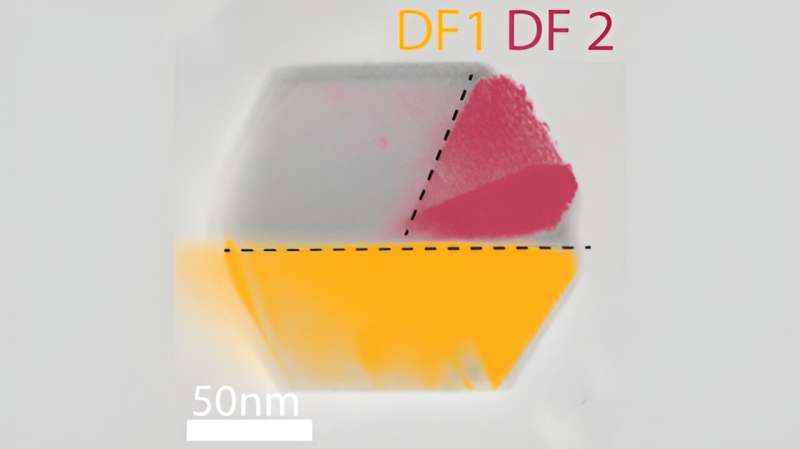
JUNE 3, 2024 by Leah Hesla, Argonne National Laboratory
Collected at : https://phys.org/news/2024-06-scientists-crystal-clarity-diamond-quantum.html
They say that one can miss the forest for the trees. But it’s often worth taking a closer look at the trees to make sense of the dense, brambly whole. That’s what a Stanford University group did to tackle a thorny quantum-information problem in diamond.
A star material for hosting quantum information, diamond nevertheless presents a challenge: Signals from the bits of quantum information embedded in diamond are often messy and inconsistent. Scientists have offered explanations for the inconsistency, but they’ve needed a way to examine diamond’s constituent parts to expose the culprit.
The Stanford group, led by Jennifer Dionne, did just that, using a powerful microscope to zoom in on diamond’s atomic-level makeup. In a paper published in PNAS, the team demonstrated that the diamond’s variegated interior largely explained the erratic signals from quantum bits embedded within.
“There had been no good way to correlate the structure of the qubit—the quantum bit—with the emitted signal, yet researchers would observe considerable heterogeneity in the emission,” said Dionne, the deputy director of Q-NEXT and a Stanford professor of materials science and, by courtesy, of radiology. “We addressed the problem, linking atomic scale structure with quantum properties.”
Silicon vacancy
The group worked with a type of qubit called a silicon vacancy center. Two carbon atoms are removed from diamond and replaced with a silicon atom. Because one atom takes the place of two, a gap sits on either side of the silicon atom—a semifilled hole.
Silicon vacancy centers are promising for quantum sensors, which can achieve many times higher precision than today’s best tools, as well as for quantum communication networks, which are, by their quantum nature, virtually eavesdrop-proof.
The Dionne group tested silicon vacancy centers in diamond nanoparticles, tiny pieces of diamond that are a few hundred nanometers across. Typically, several vacancies are scattered throughout the sample like holes in a sponge.
The signal from a vacancy center takes the form of a photon—a particle of light. In a perfect world, a vacancy-in-diamond acts as a trusty photon factory, reliably producing the same photon type every time one comes off the assembly line—same color, same brightness.
“We want indistinguishable photons,” said Daniel Angell, first author of the paper, who conducted the research while a graduate student at Stanford.
But scientists were seeing a variety of photon colors and brightnesses shooting from their diamond sources. That led the Dionne group to dig deeper.
The many facets of diamond
A diamond is a motley thing. Like most crystals, a diamond is composed of regions that abut each other like irregularly shaped Lego bricks. The regions—or domains—are differentiated by their atomic “grains,” like the grain of wood. A domain with atoms aligned on the diagonal might adjoin another with a front-to-back orientation.
The team used a scanning transmission electron microscope to examine the domains one by one, measuring the photon emission from each—an ultraprecise task that would be practically impossible with a less powerful tool. They began to notice a pattern.

This image shows a 3D perspective of the nanodiamond examined by the Dionne Group at Stanford University. Credit: Dionne Group/Stanford University
“We kept looking at these diamonds and eventually could start to see these really cool, very distinct regions of photon emission—the photon profile would differ from one region to the next,” Angell said.
The conclusion was crystal clear: Domains make a difference.
The grain of each domain shapes the vacancy inside it, stretching or squeezing it. While a vacancy in one domain might be squeezed one way, and the vacancy next door might be strained differently.
The group found that the way the vacancy is strained affects the emitted photon’s properties, as does its location within the grain structure.
Scientists had been measuring fuzzy or inconsistent signals from diamond because they’d treated the sample as a single source, a single photon emitter. But a diamond sample comprises multiple tightly packed domains, each housing its own photon emitter. Researchers had been measuring the signal from the forest, not the trees.
“The vacancy’s position within the crystal matters,” Dionne said. “The diamond’s different crystal facets and the particular orientation of the crystal can have a significant impact on both the brightness and the color of the emission.”
Even vacancies that are a scant distance apart can generate markedly different photon emissions.
“We saw a perfectly discrete jump in the emission signal when two vacancies were within only 5 nanometers of each other,” Angell said. “To see this almost perfect line of separation between emissions at the nanoscale—a clear shift in emission—is something that I’d never seen before. It’s really compelling data to look at.”
Crystal clarity
Angell correlated the different types of grain-strain to their respective photon profiles, providing researchers with a high-resolution, strain-and-emission map to better understand their own findings.
While grain variety isn’t the only factor contributing to the fuzzy photon signals, the Dionne group showed that it plays a significant part.
“We point out how it’s important to know exactly the underlying grain structure of crystal particles that are being studied. If you’re collecting the emission from the whole particle and you have blurry emission, it’s probably because there is some kind of grain boundary in there. You’re collecting different vacancies with different signatures, and you don’t know it,” Angell said.
Their work has a broader reach, too, applying to other members of the vacancy-center family of qubits.
“The door has been opened for a vast number of studies that enable precise structure-function correlation in quantum systems, and ultimately improved quantum communications, quantum networking and quantum sensing,” Dionne said.
More information: Daniel K. Angell et al, Unraveling sources of emission heterogeneity in Silicon Vacancy color centers with cryo-cathodoluminescence microscopy, Proceedings of the National Academy of Sciences (2024). DOI: 10.1073/pnas.2308247121
Journal information: Proceedings of the National Academy of Sciences

Leave a Reply